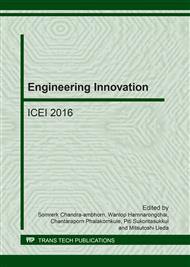p.379
p.384
p.390
p.396
p.402
p.411
p.416
p.422
p.428
Computer-Aided Design and Engineering for M16 Handguard Manufacturing
Abstract:
This work presents a computer-aided design and engineering CAD/CAE for design and optimization of M16 handguard manufacturing. A new design of handguard was developed in term of various combinations of supporting ribs inside the component. Finite Element Analysis (FEA) was used to simulate the stress distribution as well as the evaluation of supporting ribs in the component. The injection molding was used for production of the hand guard; therefore, the CAE was used to simulate the effect of gate location and gate type on the weld lines. The excessive-flash technique, which extends the fill time and continues the melt lines to flow after the melt recombination, has been introduced in order to reduce the weld lines. The simulation results indicated that the stress concentration in the loading and vent holes regions had the potential to cause the handguard to fracture. However, the combinations of vertical and horizontal ribs can reduce the stress concentration in the component. The weld lines located near the vent hole, in which the melt fronts came in contact with each other. The type and location of gates did not affect the weld line while the weld lines were observed to be strongly influenced by the excessive flash.
Info:
Periodical:
Pages:
422-427
Citation:
Online since:
January 2017
Keywords:
Price:
Сopyright:
© 2017 Trans Tech Publications Ltd. All Rights Reserved
Share:
Citation:


